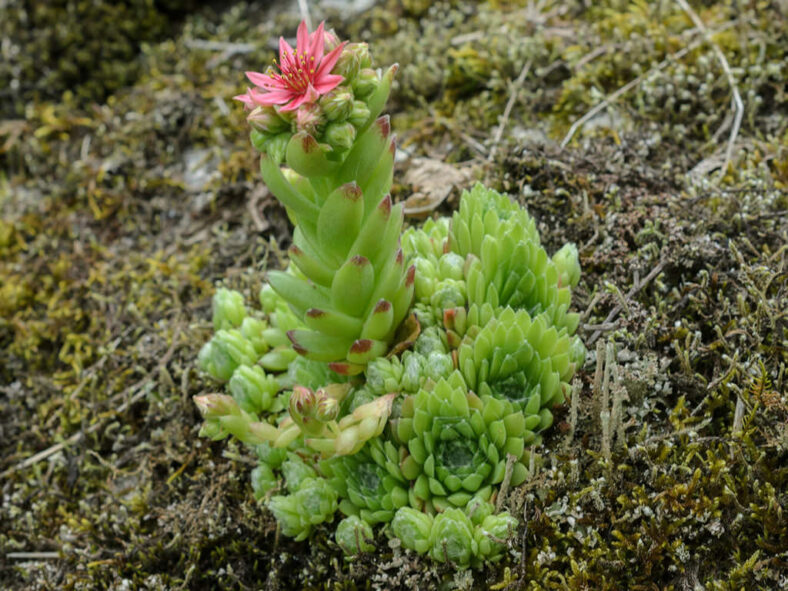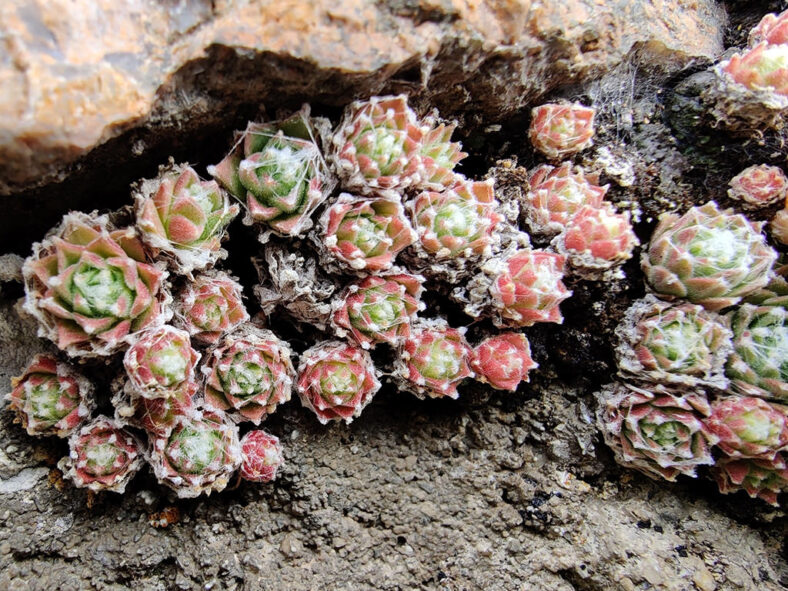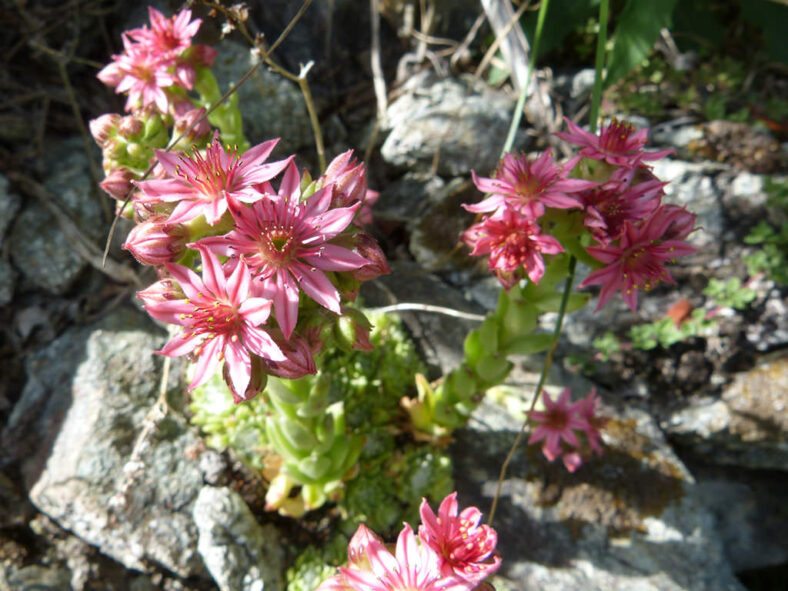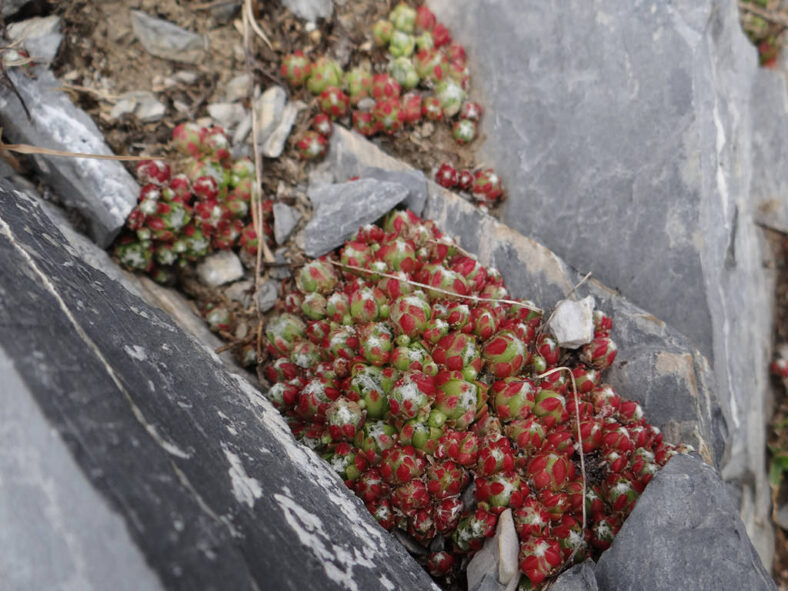Sempervivum arachnoideum is a highly variable species in terms of the size and hairiness of its rosettes. Both subspecies have gained the UK's Royal Horticultural Society's Award of Garden Merit.
Taxonomy of Sempervivum arachnoideum
Scientific Name
Sempervivum arachnoideum L.
Synonym(s)
Sedum arachnoideum
Common Name(s)
Cobweb Hen and Chick, Cobweb Houseleek, Cobweb Sedum, Spider Web Hens and Chicks
Scientific Classification
Family: Crassulaceae
Subfamily: Sedoideae
Tribe: Sedeae
Subtribe: Sedinae
Genus: Sempervivum
Etymology
The generic name "Sempervivum" (pronounced "sem-per-VEE-vum)" means "always (forever) alive" and refers to the evergreen and resilient nature of the plants that belong to the genus Sempervivum.
The specific epithet "arachnoideum" (pronounced "a-rak-NOY-dee-um") means "resembling a cobweb" and refers to the cobwebby white hairs at the tips of the leaves of this species.
Origin of Sempervivum arachnoideum
Sempervivum arachnoideum is native to the mountains of Europe, from the Pyrenees to the Carpathians.

Description of Sempervivum arachnoideum
Sempervivum arachnoideum is a succulent plant that forms a mat of compact rosettes of green leaves adorned with white, cobwebby hairs at their tips. The subspherical rosettes can reach a diameter of up to 1.4 inches (3.5 cm). The leaves are oblanceolate to oblong-obovate, incurved, and usually have brown or red tips.
During the summer, Sempervivum arachnoideum produces clusters of 5 to 15 star-shaped flowers on an upright stalk with red-tipped leaves, each with an apical tuft of cobwebby hairs. The flowers have 8 to 10 bright reddish-pink petals with a greenish keel, and can reach a diameter of 0.6 inches (1.5 cm). The flower stalk can grow up to 5 inches (12.5 cm) tall. After flowering, the mother rosette dies, but it produces many offsets before it does.
Subspecies and Forms of Sempervivum arachnoideum
- Sempervivum arachnoideum subsp. arachnoideum: This subspecies is mainly distributed in the eastern part of the native range of the species. Its rosette can reach a diameter of 0.6 inches (1.5 cm), and the quantity of cobwebby hairs can vary, sometimes being quite sparse.
- Sempervivum arachnoideum subsp. tomentosum: This subspecies is primarily found in the south-western part of the native range of the species. It has larger rosettes with diameters ranging from 0.6 to 1.4 inches (1.5 – 3.5 cm) and typically has an abundance of cobwebby hairs, which disappear in the fall and winter. The leaves of this subspecies are broader towards the tip than those of the typical subspecies (subsp. arachnoideum).
- Sempervivum arachnoideum f. bryoides
Cultivars and Hybrids of Sempervivum arachnoideum
- Sempervivum arachnoideum 'Cebenese'
- Sempervivum arachnoideum 'Emily'
- Sempervivum arachnoideum 'Robin'
- Sempervivum arachnoideum 'Rubrum'
- Sempervivum arachnoideum 'Viridescens'
- Sempervivum ×barbulatum
How to Grow and Care for Sempervivum arachnoideum
Light: This plant prefers full sun but will appreciate some afternoon shade, especially in hot climates. It is not suitable for indoor growing, as it typically does not receive sufficient sunlight.
Soil: To ensure that Sempervivum arachnoideum thrives, use a well-draining soil mix with 25 to 50 % sand, gravel, and perlite or pumice. A commercial soil mix designed for succulents should keep the roots dry and healthy if planted in a pot.
Temperature: Sempervivum arachnoideum is ideal for cold climates, as it can withstand freezing temperatures. It is also heat-tolerant but prefers average summer temperatures between 65°F and 75°F (18°C and 24°C). This plant grows best in USDA Plant Hardiness Zones 5a to 8b, with average minimum winter temperatures ranging from -20°F to 20°F (-28.9°C to -6.7°C).
Watering: Water thoroughly during the spring and summer, allowing the soil to dry out between waterings. Reduce watering in the fall when Sempervivum arachnoideum enters dormancy. Mature rosettes planted in the ground can overwinter without additional water, whereas potted plants may require a little water to make it through the winter. Avoid letting water sit in the rosette or beneath the pot.
Fertilizing: This plant can thrive without feeding, but benefits from a controlled-release fertilizer at the beginning of the growing season. Alternatively, you can fertilize once a week with a diluted liquid solution.
Repotting: Container plants will benefit from repotting. It's best to repot them as needed, preferably in the spring.
Propagation: The easiest way to propagate Sempervivum arachnoideum is by dividing the offsets it produces each season. The best time to divide the offsets is in spring or summer when they are at least a quarter of the size of the mother rosette. Propagation by seeds is also possible; sow the seeds in the fall to have seedlings ready for transplanting in the spring.
Learn more at How to Grow and Care for Sempervivum.
Uses of Sempervivum arachnoideum
The crushed leaves or their juice can be applied externally to treat boils, wounds, and similar issues. They are also effective in stopping nosebleeds. When slightly warmed, the juice is used to relieve ear inflammation, and chewing on the leaves can alleviate toothaches. Additionally, when macerated and infused in vinegar, the plant can help remove warts and corns.
The leaves are best harvested in the summer and should be used fresh, as they are difficult to dry properly. The pulp of the leaves can be used to create a cooling face mask for reddened or sunburned skin.
Toxicity of Sempervivum arachnoideum
Sempervivum arachnoideum is not known to contain toxic compounds, making it a safe plant for pets and children.
Links
- Back to genus Sempervivum
- Succupedia: Browse succulents by Scientific Name, Common Name, Genus, Family, USDA Hardiness Zone, Origin, or cacti by Genus
Photo Gallery
Click on a photo to see a larger version.


